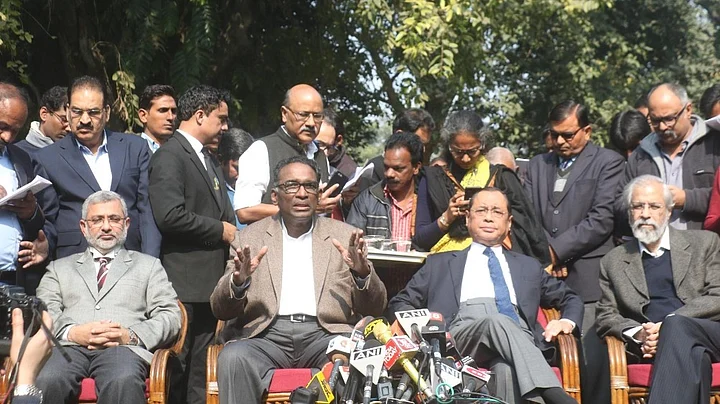Friday’s unusual and unprecedented event of four senior-most judges of the Supreme Court was an implosion which many, who observe the institution closely, could see coming for quite sometime now. There was lingering internally a deep sense of dissatisfaction on the manner successive Chief Justices ran the court in the recent past. It is only that a flash point occurred now, and resulted in the unprecedented step of a press conference.
- The collegium mechanism changed the CJI’s position in relation to his four other senior colleagues
- The press conference is a symptom of an institutional malady for which a long term cure is required
- Perhaps filling the institutional gaps created due to the collegium system can solve the problem
- We need to carry forward the momentum of the press conference
A Crumbling System?
When, through judicial interpretation, the Supreme Court made an endeavour to protect the independence of the judiciary by devising the ‘collegium’ mechanism of a group of senior judges acting in a collegiate manner to appoint judges, the institution of Chief Justice also changed fundamentally, at least in relation to his four other senior colleagues.
The judgment institutionalised a sort of power hierarchy, which the other four perceived transcends issues of appointment and pointed towards the court being run in a consultative manner by the group of five senior most judges, including the Chief Justice.
However, in practice, successive Chief Justices, who typically have short tenures, did not see it this way. A combustible mix of intense bargain on choice of candidates sometimes also made the Chief Justice to perceive a grouping against himself, and as a reaction, becoming more unilateral in other spheres of functioning of the court, reflecting it in various administrative decisions, including allocation of work, holding permission to travel and other acts by which others felt their stature being trivialised.
A judge within the collegium, who was heading a very important committee of Supreme Court, which by its nature demanded continuity and in which area he had done seminal work, found himself removed one fine day, replaced by a retired judge of a High Court.
The psychological brutality of this act was similar in force to that of a group of primates where an alpha male gorilla exhibits traits of dominance by keeping most of the food to himself, shares well with others who accept his dominance willingly and nearly starves those who do not, thereby establishing a power hierarchy in the group though a behaviour of dominance.
However, the net outcome of Friday’s event is not to have a knee jerk reaction by ascribing all the faults to an individual, but to read it as a symptom of an institutional malady for which a long term cure is required, as otherwise this sort of dynamic of power relationship may continue in the same way as others, when they graduate to being the alpha male in the group, may end up exhibiting the same trait of dominance.
A Possible Solution
The answer perhaps lies in filling the institutional gaps, which were formed when the devise of collegium was created through a judgment. The responsibility of selecting judges devolved on three or five judges for appointments to High Courts and Supreme Court, resulting in significant additional work, with no support structures and machinery created to operationalise it.
Also, judges, who remain largely overworked due to their normal judicial dockets, which are enormous and are their primary responsibility, have no time to set up norms or make long term policies. Short tenures of Chief Justices further denude this institutional capacity. The result is exercise of administrative power by Chief Justice, which is, many times, perceived to be arbitrary, individualistic, resulting too frequently in inconsistencies and abruptness.
One solution which was suggested by this writer to the previous Chief Justices was creation of a body on the broad lines of a National Judicial Policy and Planning Institute, an independent institution within the judiciary, like the current judicial academies.
This institute through its various centres, can address different areas of judicial policy and governance, developing norms and best practices. Right now Supreme Court has various committees lacking firm institutional structures to carry out sustained reforms.
Once the matter of internal governance has been brought by the senior most members of the judiciary in public domain, a positive outcome of it can be to carry on the momentum to press for institutionalised reforms to fill the gaps by creating structures for judicial self-governance. Otherwise, it may well end up being a case of ‘too much sound and fury, signifying nothing’, as it has led to a virtual cacophony with people in general being confused from where it is coming and to what it will lead.
(Prashant Kumar is the President Elect to the Bar Association of India.The views expressed above are of the author’s alone and The Quint neither endorses nor is responsible for them.)
(We Indians have much to talk about these days. But what would you tell India if you had the chance? Pick up the phone and write or record your Letter To India. Don’t be silent, tell her how you feel. Mail us your letter at lettertoindia@thequint.com. We’ll make sure India gets your message.)
(At The Quint, we question everything. Play an active role in shaping our journalism by becoming a member today.)
